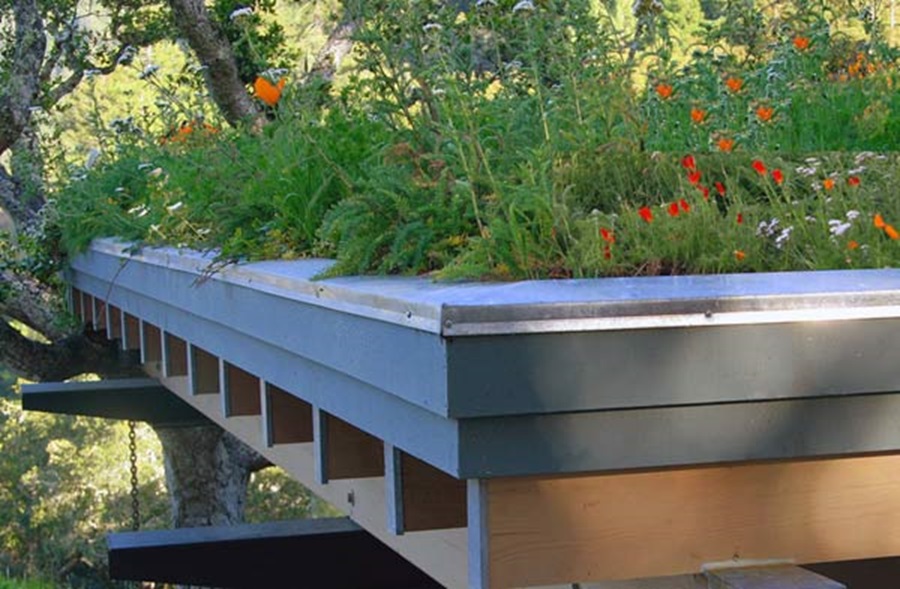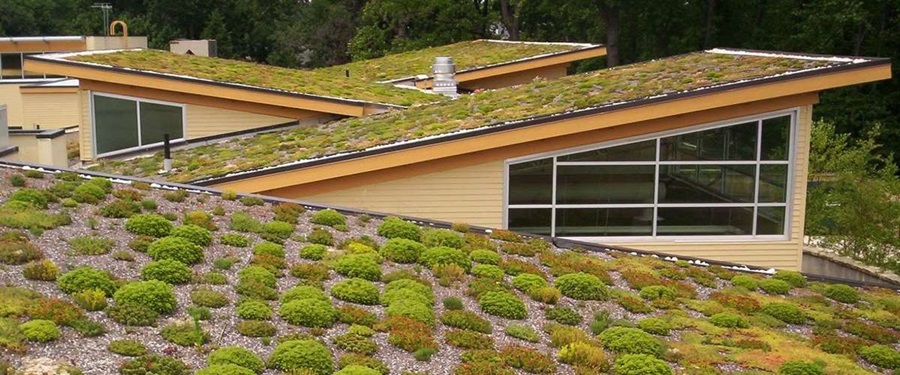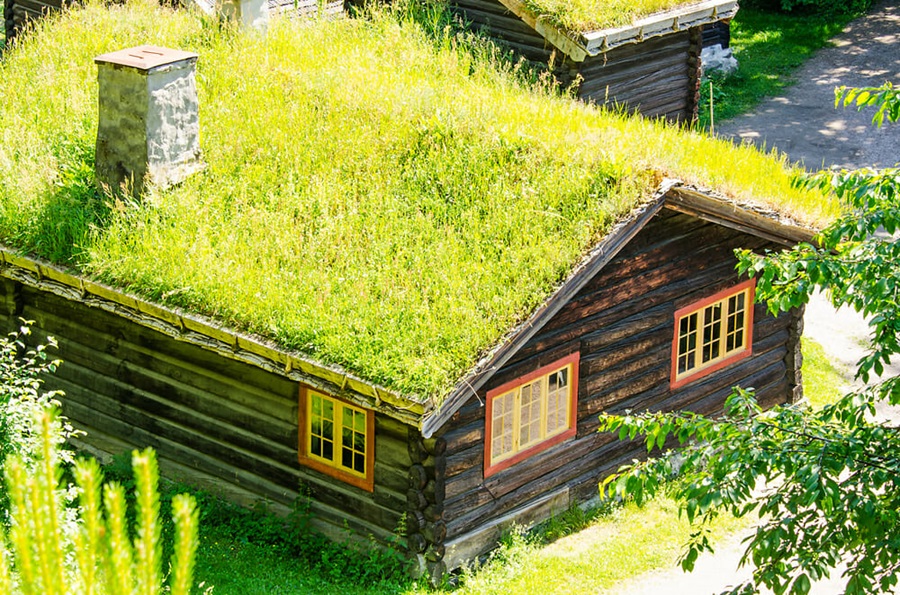Reclaimed slate or clay tiles are the most eco-friendly options for green roofing on gable roofs. They are durable and have been used for roofing for centuries.
When it comes to environmentally-friendly roofing options for gable roofs, it is important to consider materials that are both sustainable and energy-efficient. Green roofing has emerged as a popular choice among homeowners and builders who are conscious about reducing their environmental impact.
Green roofs not only provide insulation and reduce heat transfer, but they also contribute to improving air quality and stormwater management. We will explore different green roofing options specifically designed for gable roofs, focusing on materials that are both eco-friendly and aesthetically pleasing. Whether you are looking to enhance the energy efficiency of your home or create an eco-friendly living space, these green roofing options are worth considering for your gable roof.

Introduction To Green Roofing
Introducing green roofing options for environmentally-friendly gable roofs, offering sustainable and eco-friendly alternatives to traditional roofing materials. Explore options such as reclaimed slate or clay tiles, which are not only durable but also have a minimal impact on the environment.
What Is Green Roofing?
Green roofing, also known as living roofs or eco-roofs, is a sustainable roofing option that involves the installation of vegetation on the roof surface. Instead of conventional roofing materials like asphalt or metal, green roofing utilizes vegetation, soil, and special growing mediums to create a functional and environmentally-friendly roof.
Benefits Of Green Roofing
Green roofing offers a range of benefits that make it an attractive option for environmentally-conscious homeowners and businesses:
- Improved air quality: The vegetation on green roofs acts as a natural air filter, removing pollutants and improving the quality of the air.
- Noise reduction: The layers of soil and vegetation absorb sound, making green roofs an effective way to reduce noise pollution, especially in urban areas.
- Energy efficiency: Green roofs provide excellent insulation, reducing the need for heating and cooling. This can lead to significant energy savings and lower utility bills.
- Stormwater management: Green roofs absorb rainwater, preventing excessive runoff and reducing the strain on stormwater systems. This helps to prevent flooding and mitigate the effects of urban heat islands.
- Increased biodiversity: Green roofs create habitats for various plant species and attract wildlife, promoting biodiversity in urban environments.
- Extended roof lifespan: The layer of vegetation acts as a protective barrier, shielding the roof membrane from the elements and extending its lifespan.
These are just a few of the many benefits that green roofing offers. Whether you are looking to reduce your ecological footprint, improve the aesthetics of your property, or create a sustainable urban environment, green roofing is an excellent choice for environmentally-friendly gable roofs.
Green Roofing Materials
Green roofing materials offer environmentally-friendly options for gable roofs, providing sustainability and energy efficiency. From reclaimed slate and clay tiles to composite shingles and solar reflective coatings, there are various eco-friendly choices available for those looking to minimize their environmental impact while maintaining a beautiful roof.
When it comes to choosing green roofing materials for your environmentally-friendly gable roof, there are several options to consider. These materials not only contribute to sustainability but also provide a beautiful and unique aesthetic to your home. In this article, we will explore three popular green roofing materials that are suitable for gable roofs: Reclaimed Slate or Clay Tiles, Alternative Sustainable Materials, and Solar Shingles.

Reclaimed Slate Or Clay Tiles
The use of reclaimed slate or clay tiles for roofing is a sustainable and eco-friendly choice. These materials have been used for centuries and are known for their durability and longevity. By opting for reclaimed tiles, you not only reduce the demand for new production but also give a second life to materials that might otherwise be discarded. Reclaimed slate or clay tiles are not only stylish but also provide excellent insulation and can withstand harsh weather conditions.
Alternative Sustainable Materials
If you are looking for more unconventional green roofing options, alternative sustainable materials can be a great choice. These materials are often made from recycled content, such as rubber, plastic, or wood fibers, making them an eco-friendly alternative to traditional roofing materials. Additionally, alternative sustainable materials are lightweight, easy to install, and can be customized to fit any gable roof design. They offer excellent insulation properties and can help reduce energy consumption.
Solar Shingles
The use of solar shingles is a smart and innovative way to make your gable roof more environmentally-friendly. These shingles incorporate solar panels into their design, allowing you to generate clean and renewable energy directly from your roof. Solar shingles are a blend of functionality and style, as they seamlessly integrate into your roof surface while providing a sustainable energy solution for your home. By harnessing the power of the sun, you can reduce your carbon footprint and save on energy costs.
In conclusion, when it comes to green roofing materials for environmentally-friendly gable roofs, options like reclaimed slate or clay tiles, alternative sustainable materials, and solar shingles provide excellent choices. These materials not only contribute to sustainability but also offer durability, insulation, and energy efficiency. Consider these green roofing options for your gable roof and make a positive impact on the environment.
Choosing The Right Green Roof
When it comes to environmentally-friendly gable roofs, choosing the right green roof is crucial. Not only does it add aesthetic appeal to your home, but it also contributes to sustainable living and helps reduce your carbon footprint. In this section, we will explore the best roof design for the environment and the factors to consider when selecting a green roof. Additionally, we will discuss suitable roof types that are perfect for accommodating a green roof system. Let’s dive in!

Best Roof Design For The Environment
When it comes to green roofs, there are several design options that are considered best for the environment. These roof designs maximize the benefits of a green roof and provide optimal environmental advantages. Some of the best roof design options include:
- Sloped roofs with a gradient of 30-45 degrees
- Flat or low-pitched roofs
- Green roofs with a combination of vegetation and solar panels
These roof designs allow for sufficient drainage, provide ample sunlight for vegetation growth, and are structurally capable of supporting the weight of a green roof system.
Factors To Consider
Before selecting a green roof for your gable roof, there are several factors you should consider. These factors will ensure that you choose a green roof that not only suits your needs but also provides maximum environmental benefits. Some essential factors to consider include:
- Climate: Consider the climate in your area, as different vegetation thrives under different climate conditions. Choose plants and vegetation suitable for your region to ensure they flourish and maintain their health.
- Structural Capacity: Determine the structural capacity of your gable roof to support the additional weight of a green roof system. Consult a professional if needed to ensure the roof can accommodate the extra load.
- Maintenance: Consider the maintenance requirements of the green roof system. Some plants may require more attention and care, while others are more resilient and low-maintenance.
- Cost: Evaluate the cost of installation, maintenance, and long-term benefits of the green roof. Consider your budget and weigh the expenses against the environmental advantages.
Suitable Roof Types
Not all roof types are suitable for accommodating a green roof system. Certain roof types provide better support, drainage, and structural integrity for green roofs. Here are some suitable roof types for green roofing:
| Roof Type | Description |
|---|---|
| Sloped Roofs | Ideal for drainage and vegetation growth, with a gradient of 30-45 degrees. |
| Flat Roofs | Easier to install and maintain green roof systems, with proper waterproofing and drainage systems. |
| Low-Pitched Roofs | Provide a versatile platform for accommodating green roofs, with suitable modifications for drainage. |
These roof types offer the necessary foundation for a successful green roof system and ensure long-term sustainability.
By considering the best roof design for the environment, evaluating the relevant factors, and selecting a suitable roof type, you can make an informed decision when choosing the right green roof for your gable roof. This not only benefits the environment but also enhances the overall look and value of your home. So, go ahead, make a sustainable choice, and embark on your green roofing journey!
Frequently Asked Questions Of Green Roofing Options For Environmentally-friendly Gable Roofs
What Is The Most Eco-friendly Roof Material?
The most eco-friendly roof material is reclaimed slate or clay tiles, which have been used for roofing for centuries. These tiles are highly sought after for their sustainability and environmental benefits. Reclaimed tiles are the top choice for eco-conscious roofing.
What Is The Alternative To A Green Roof?
The alternative to a green roof is a brown roof, which is installed similarly but uses recycled building materials and soil to create a habitat for flora and fauna. It is a more eco-friendly option that supports biodiversity.
What Is The Best Color Roof For The Environment?
The best color roof for the environment is white, beige, or tan. These colors are the most energy-efficient and can help keep your home cool in warm climates. However, if you live in a cold climate, a cool roof may not be the best option.
Metal roofing and cedar shakes are also eco-friendly materials to consider.
What Is The Best Roof For A Green Roof?
The best roof for a green roof is a low-pitched or flat roof, as long as the structure can support the weight of the green roof system.
Conclusion
Overall, it is clear that there are a variety of green roofing options available for environmentally-friendly gable roofs. Reclaimed slate or clay tiles are the most eco-friendly choice, while other sustainable materials like metal and concrete can also be budget-friendly options.
Additionally, green roofs provide benefits such as heat control and utilization of renewable resources. By choosing eco-friendly roofing materials, homeowners can contribute to a greener and more sustainable future.
Tags: eco friendly homes, energy efficiency, environmentally friendly, go green today, green home design, green roofing, roofing ideas, sustainable living



